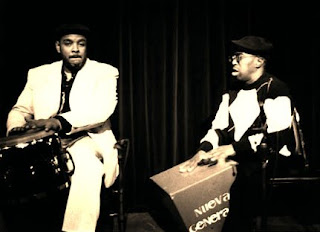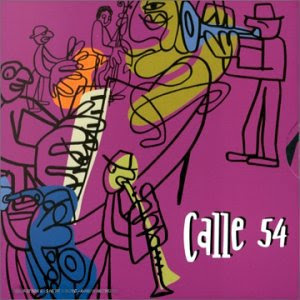
Música Tradicional Spirituana Vol. II
Tonadas Trinitarias
Conjunto Folklórico de Trinidad
(1987)
EGREM LD-4383
Track List:
Side A:
1. Los negros congos (2:56)
2. El Simpá y el Tamarindo (2:46
3. Tu has venido al mundo (3:00)
4. Delirio (2:44)
5. A la calle me voy (2:20)
6. Pa' los mayores (2:46)
7. Gloria llegó (1:32)
Side B:
1. Para el santo Juan de Dios (2:33)
2. Yo vengo a pedir merced (1:58)
3. Las mañanas de San Juan (2:00)
4. Canta Juana (2:50)
5. La independencia (4:52)
6. Una corona al general Maceo (3:24)
I'm not sure now when I first came across the term "tonada trinitaria." I was thinking it was with Afrocuba de Matanzas' 1996 release "Raices Africanas" which included "Pa' los mayores":
Yo traigo pa’ los mayores
de Pueblo Nuevo
(bis)
Yo traigo los angelitos vestidos de oro
Las flores más elegantes de mi cantero
Clara le dijo a Cirilo,
“Cirilo, no me busques más”
Cirilo le dijo a Clara,
“Tú eres la mujer,
Tú eres la mujer de mi corazón”
Tun, tun, tun ¿quién va?
Tun, tun, tun ¿quién va?
“Soy tu marido mujer,
¿No me conoces la voz?
Abre la puerta por Díos
Que eso sí no puede ser”
Coro: Llorona llorona, llorona no llores más
But checking the liner notes to that disc, I see that is listed as a yambú, of matancero coro de clave origin, with no mention at all made of tonadas trinitarias. So maybe it was somewhere else.
Anyway, this song "Pa' los mayores," with it's beautiful melody and seemingly strange narrative (Who are Cirilo and Clara? What do they have to do with the flowers to Pueblo Nuevo? And who is the "llorona"?) has become something of a standard in the rumba repertoire, and I have often wondered about it and tonadas trinitarias in general. What are they exactly? How did they sound originally? It's been very difficult to find anything in-depth written about them, and even harder to find any recorded examples.
Today we can attempt to answer some of these questions.
I recently came across the LP pictured above, which is the most comprehensive recording of tonadas trinitarias that I am aware of. Long out of print, we are happy to bring it to the light of day here to help spread awareness and enjoyment of this obscure genre.
To help answer some of our questions, our friend Johnny Frías, an ethnomusicology student at the University of Florida has shared this article with us:
Tonadas Trinitarias
by Johnny Frías
© 2008 Johnny Frías
The tonada trinitaria is a musical manifestation from Trinidad de Cuba, a town in the central part of the island of Cuba known for its colorful colonial architecture and cobblestone streets.
 Trinidad de Cuba
Trinidad de Cuba(Photo: Wikipedia)
The genre has a clear African ancestry and influence from the music of the white Cuban campesinos (country peasants).
Trinidad was the most important center of sugar cane production in the province of Las Villas [today Sancti Spíritus] during the nineteenth century. The third city founded in Cuba, it was an important Caribbean port and center of contraband due to its central location on the southern coast of Cuba.
Coinciding with the growing demand for sugar in the nineteenth century, a large number of slaves were brought into the Valle de San Luís (today called Valle de los Ingenios), the fertile valley home to Trinidad’s sugar cane production. It was here in the rural area surrounding Trinidad that the tonada trinitaria first developed.
["Tonadas Trinitarias" simply means "tunes from Trinidad" though the term "tonada" is used to describe various other campesino musics of Cuba as well. - Ed.]
In the slave barracks, the Africans and their descendants were exposed to the music of their white campesino neighbors, who improvised décimas to the accompaniment of stringed instruments. They absorbed some of these influences, and along with their ingenuity produced the basis for what would be further developed in the urban areas of Trinidad.
The tonadas trinitarias may have existed as early as 1851 according to information collected by Enrique Zayas. They were practiced and popularized among the poor blacks, mulattoes and whites of the marginal neighborhoods, and preserved in the cabildos of the many African ethnic groups.
By the 1860s this music – known early on as tango and then fandango – was being performed by singers and drummers during the religious holidays and festivals of Trinidad. Singers and groups formed from the different barrios, or neighborhoods, of the town and met to sing, dance, compete, and parade through the streets, much the same as the coros de clave.
The groups are made up of lead singers called guías or gallos, a chorus of mixed voices, and drummers. The musicians are known as tonadistas. The music itself is based on a repeated chorus between which competing gallos improvise poetic lines based on the theme.
The gallo begins with the theme (tema or estribillo) and is immediately joined by the percussion, then answered by the chorus. The primary rhythm is in 12/8, although in practice it contains rhythms in the melody and percussion that are in 2/4. These groups interpret rumba as well in this format, yet primarily perform tonadas, of which there are hundreds.
Song themes may be patriotic, amorous, religious, or comment on other social situations. They have been transmitted orally through the generations and are now truly the domain of folklore, as none of the authors are known.
The instruments include three drums specific to the tonada trinitaria, a muela or guataca (hoe blade) and a güiro. The drums, due to their tuning style, have a clear Carabalí ancestry, but were shortened to facilitate the ambulatory nature of the groups. They are called [from lowest pitch to highest] bombo or salidor; un solo golpe or marcador; and quinto. The muela, güiro, bombo, and marcador repeat patterns over which the quinto improvises.
 Drum used in tonada trinitaria ensembles.
Drum used in tonada trinitaria ensembles.tuning mechanism with drums used in Abakuá,
of Carabalí (southern Nigeria-Cameroon frontier) origin (below).

Tend to be slightly conical in shape,
as opposed to the tubular shape
of those used in tonadas trinitarias.
(Photo credit: Folkuba.com)
Presently there is only one published recording of tonadas trinitarias, by the Conjunto Folklórico de Trinidad, which still includes some tonadas as part of their repertoire performed at the Palenque de los Congos Reales.
Sadly, most of the actual groups dedicated to the tonadas trinitarias are no longer active, and the surviving repertoire is limited to the memories of a select few tonadistas. It is a personal goal of mine to research, document, and promote this genre in order to preserve this beautiful music for future generations.
*******
Bibliography:
Esquenazi Pérez, Martha. Del areito y otros sones. La Habana: Ediciones Adagio, 2007.
Giro, Radamés. “Tonada trinitaria.” Diccionario enciclopédico de la música cubana.
2007.
Zayas, Efraín. Personal interview. 7 July 2008.
Zayas Bringas, Enrique. “La tonada trinitaria: También es campesina.”
We'll add here a few key excerpts from Rolando Pérez's article "El tambor en las tonadas trinitarias" in Clave, La Habana, 1986:
"Las tonadas dejaron de salir a la calle en 1958, ya muertos Alfonso Puig y Venerando Lugones, sus propulsores. Sus respectivos sobrinos: Manuel Quesada Puig y Francisco Cuéllar Lugones...continuaron, algunos años más tarde, la vieja tradición."
("The tonadas stopped performing publicly in 1958, with the deaths of Alfonso Puig and Venerando Lugones, its main protagonists. Their respective nephews, Manuel Quesada Puig and Francisco Cuéllar Lugones picked up the old tradition a few years later.)
"En tiempos pasados se establecían controversias entre los grupos de tonadas de diferentes barrios como los de Jibabuco y el Simpá, en las que se decían, a través del canto, las cosas que se sabian uno de otro. Es por ello que, al decir de Manuel Quesada (Bola), las tonadas eran cantos de picapleitos que a menudo terminaban de bronca."
("In times past there were "controversias" (verbal duels) among the tonada groups from different neighborhoods such as Jibabuco and el Simpá, in which they said, through song, the things that were known about each other. This is why, says Manuel Quesada (Bola), that the tonadas were contentious songs that frequently ended in fights.")
"Las tonadas se cantaban y tocaban en ocasión de la Fiesta de San Juan y San Pedro los días veintitrés y veintinueve de junio respectivamente. La víspera de San Juan cantaba por las calles durante toda la noche, y al amanecer los músicos iban al rio y se lavaban la cara con sus aguas, costumbre que evidencias las vinculaciones religiosas de esa tradición musical."
("The tonadas were sung and played in the Fiestas de San Juan and San Pedro. on the 23rd and 29th of june respectively. On the eve of San Juan there was singing in the streets all night long, and at daybreak the musicians went to the river and washed their faces, a custom in which the religious links of this tradition are evident.")
"Según nos han comunicado, las tonadas se tocaban también en las festividades de San Antonio (trece de junio), patrón del Cabildo de Congos Reales de Trinidad. En relación con esto debemos recalcar que las tonadas trinitarias han estado asociadas en su desarrollo con dicho cabildo. Algunos de los integrantes pertenecian y pertenecen aún al grupo de tonadas. Un ejemplo de ello fue Venerando Lugones, quien era cajero - tocador de caja - en el cabildo y tocador de quinto en las tonadas."
("According to what we have been told, tonadas were also played in the festivals of San Antonio (13th of June), patron saint of the Cabildo de Congos Reales de Trinidad. In relation to this we should emphasize that the development of the tonadas trinitarias has been associated with this same Cabildo. Some of the members once belonged and still belong to tonada groups. An example was Venerando Lugones, who was cajero - (caja, or large drum player) - in the cabildo and quinto player in the tonadas.")
To go back to "Pa' los mayores," just to show you how confusing Cuban music can be, we see this song referred to as a yambú by Afrocuba de Matanzas, yet it seems to contain elements of at least three different genres of Cuban music: a tonada trinitaria, "Cirilo y Clara" which Helio Orovio refers to as a conga, and finally Rolando Pérez tells us that "Llorona llorona, llorona no llores más" is actually a "rumba managua," a musical genre about which Pérez tells us little other than that it was accompanied by the same drums as the tonadas.
Listen here to "Pa' los mayores" in its (original? Does Trinidad even have a Pueblo Nuevo barrio like Matanzas does?) version as a tonada trinitaria:
Download the full album here.






























